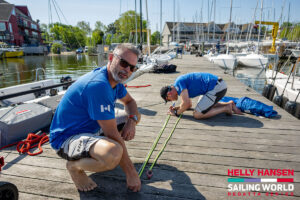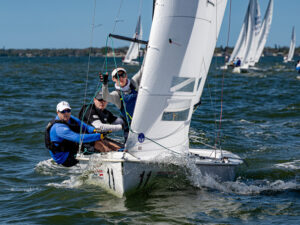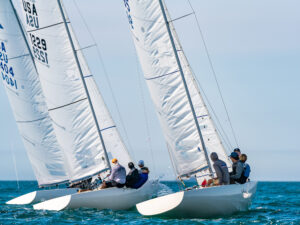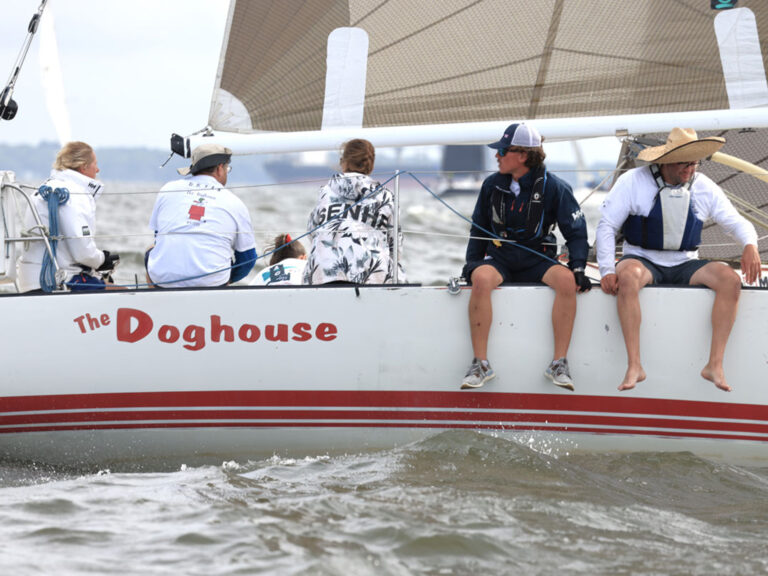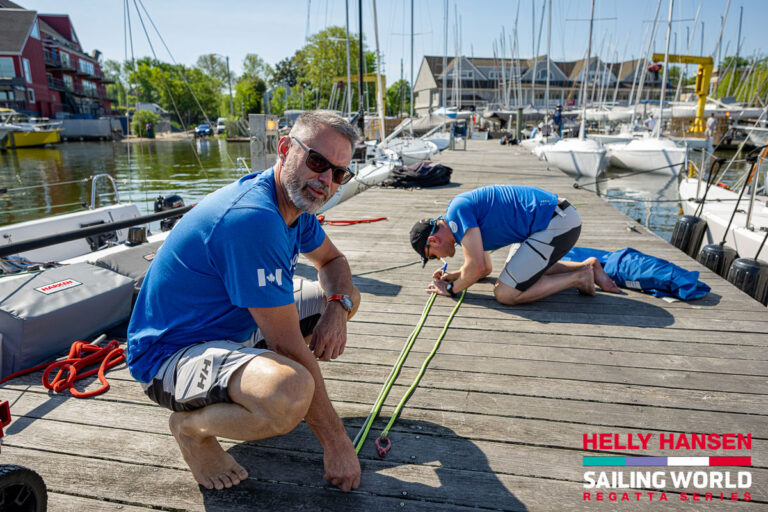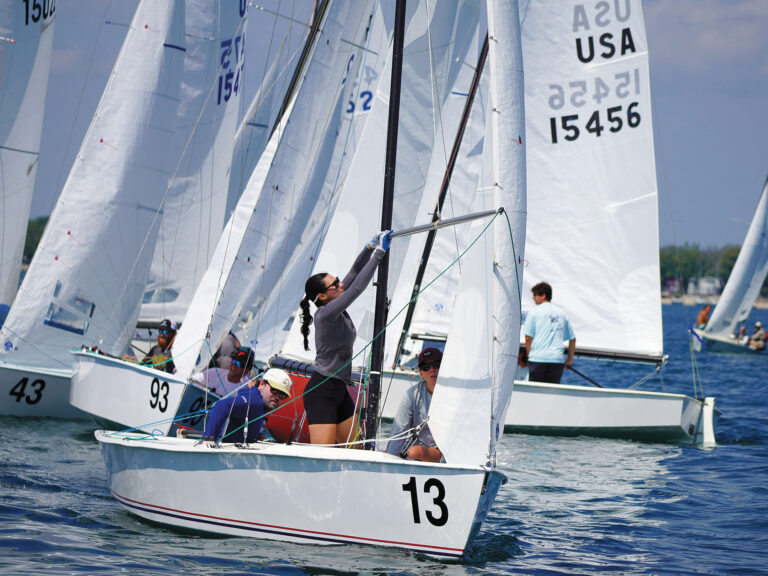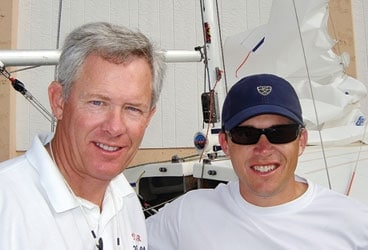
AugExpFisherSt
The pair of Marcus and Marc Eagan is a tough two-generation team to beat in the Flying Scot. They’ve dominated many of the class’s major championships of late, and this year’s Midwinter Championship was yet another. Not only do they somehow sail the boat extremely fast, but they do it time and time again. We checked in with the younger Eagan to learn what’s at the root of this father/son team’s rise to prominence in the Scot class.So Marcus, what is it that makes you guys so good?We spend a lot of time making sure the boat and all of its rigging is in working order. It is important to eliminate any variables so that we can concentrate “outside” the boat while racing. Since we usually have good boat speed, our sailing style as a whole can be very conservative and I feel that pays throughout an event, especially when there’s not a throwout as in most Flying Scot regattas.Perhaps one of the most impressive things about your sailing, and your victories, is the fact that you have done it all with your father.We have a lot of fun sailing together as well as being with one another at the regattas. My father, in his own right, is a great sailor and it’s always good to get out of the office together and have some fun doing something we both love.Together you guys fall at the light end of the weight range, so what do you guys do with your boathandling and tuning in order to be as competitive as you are in bigger breeze? There are only so many options for de-powering in the Flying Scot. The first and most critical de-powering tool is the vang. As the wind increases, the boat always seems to sail faster, and more controlled upwind, as you apply more vang.The next adjustment is to move the jib lead aft. This flattens the foot and also opens the leech. I recommend doing this in small increments, as the leads are already placed well aft in the Scot. Another area we also play with is the amount of windward sheeting on the jib. While windward sheet tension in the breeze will help increase power and pointing in the Scot, too much can make the boat harder to steer and rob the boat of forward speed. We gauge windward sheet tension by the angle of the top batten and make sure the batten is always angled open in breeze when we are overpowered.You two have always demonstrated excellent boatspeed in the Scot, no matter what boat you sail. What areas do you guys focus on to be sure a boat is set up and prepared properly?As we approach every event we make sure all the small things are taken care of. For example, before Midwinters we put on a new [centerboard] gasket and made sure the bottom was as fair and smooth as we could. We set our boat up to the standard North Sails rig-tuning guide. Our rake was 28’5″ and we had close to 80 pounds of tension on the forestay. We also try to arrive at the regatta a few days before the event so we can practice and experiment with a few minor adjustments just to see how they work. The great thing about a Flying Scot is that it is still a Flying Scot . . . and there are only so many things you can do to the boat. The Class Rules are tight, which maintains close competition.You guys did have an exciting moment the last race where the regatta win was in jeopardy; what happened and how did you save it?We definitely had a bit of father-and-son bonding in that last race. Before the race we said to ourselves that we just had to be safe in everything we did. We were in good shape points-wise and just needed to be careful. We rounded the top mark in the breeziest race so far in the series in second and were very pleased. However, as soon as the chute filled the boat rounded up and we flipped over. Once a Flying Scot has turned over and swamped it is quite a project. After about 5 minutes, some serious bailing and losing about 15 boats, we finally got back on the racetrack. We rounded the bottom mark in 15th and were able to claw back to ninth by the second weather mark. We held this position to the final bottom mark, where they shortened the race due to the increasing wind. It was an exciting time for us, and after the race my dad mumbled something about his driving at the next event. Both you and your father grew up at Bay Waveland YC in Bay St Louis, Miss., a club that has produced many champions. What is it that makes you all so competitive?Our club has developed a racing format that encourages eight boats to sail six races every weekend. There are a bunch of people, very talented sailors, who take advantage of this competition. At the end of the season there’s a club championship. Throughout the weekend series, many people of all skill levels come out and race and enjoy the experience of sailing with each other. When you have so many good sailors sailing against each other every weekend it brings everyone up a level.We know Katrina devastated many of the Gulf Yachting Association clubs. How did Bay Waveland YC fare?The only thing left of BWYC is the parking lot and the members’ spirit. After the storm, everything was wiped off the lot-the devastation was total.Are there plans to rebuild the club and sailing program? The club currently has two mobile trailers joined by a large deck. Hopefully within the next two years we can rebuild a new club similar, or even bigger than what we had before. On the other hand, the sailing program was running as of April 1, and the yacht club has many new Flying Scots on order.Your family has a summer home a few hundred yards from Bay Waveland YC and one in New Orleans a few miles from Southern YC. How bad was your damage?We didn’t fare too well; our summer home in Mississippi was leveled. The only thing left was the stairs leading to the front door. In New Orleans, our home had 8.5 feet of floodwaters that approached the second floor. We lost three cars, but worse, a lot of memories.You were a three-time All-American at College of Charleston, arguably one of the most competitive schools around. Do you think that has helped your sailing? Do you have suggestions for those considering collegiate sailing?I was very fortunate to sail far Doc Wood and the College of Charleston. The program that he has developed throughout his coaching career at CofC is extraordinary. Sailing at a top-notch program like we had gave me the opportunity to grow in my sailing career. College sailing has definitely improved my sailing in a way that makes me feel more comfortable in tight situations, such as at mark roundings or starts. In collegiate sailing the race comes together at the top fourth of the upwind beat, and this experience every weekend is great.Have you considered an Olympic campaign? What kind of boat wouldinterest you the most?While an Olympic campaign would be exciting, I just don’t have the time or interest at this point in my life. But recently I’ve been sailing an A Class catamaran. That type of sailing is a “bit” different than Scot racing. I haven’t gotten my Dad out on it yet. I’ll be doing some weekend races throughout the summer as well, and crewing for my brother, and maybe we’ll even sail the Flying Scot North Americans together in Marblehead.

